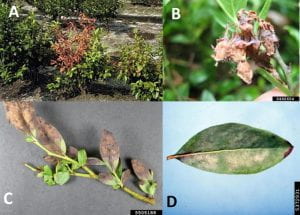By Haley Sater
Agriculture Agent, Wicomico County
University of Maryland Extension
HSater@umd.edu
( Article from May 2021 issues of UME Fruit and Vegetable Newsletter)
Most blueberry cultivars here in Maryland bloomed and green fruit are developing. Now is the time when a variety of pathogens and pest will begin to take up residence in your field which can harm your developing crop. It is important to perform routine scouting throughout your farm and make sure that you’re not seeing symptoms of some of
the common pests and pathogens. Below is a description of several of the most common diseases and pests you may find at this time in your blueberries.
Pathogens to be on the lookout for:
During the cool, wet days where temperatures do not reach above 70 degrees you may begin to see symptoms of several fungal pathogens including botryosphaeria canker or stem blight, botrytis, anthracnose and powdery mildew. These conditions make for an ideal environment for some of these fungal pathogens to grow or spread.

Botryosphaeria stem blight (A) will exhibit dieback symptoms. It is initially detectable as yellowing and reddening of leaves which will move down then stem as vascular tissue becomes blocked by the pathogen. Whereas, botryosphaeria canker will develop as stem lesions which will sometime become swollen resulting in the formation of a canker. If botryosphaeria stem blight or canker is observed the best method to prevent the spread is pruning the infected tissue and fruit clusters six inches below any infected stems. Then, remove pruned branches from the field.
Botrytis (B) also known as gray mold, affects both fruit and the plant. It infects the fruit from bloom. As with botryosphaeria, the best tactic to reduce the spread of this disease is by pruning out infected fruit clusters and wood, then removing clippings from the field.
Anthracnose (C) will appear as stem, bud and leaf lesions and may have orange spore masses. Infections will cause leaf browning and will move from top of the leaf to the bottom. If untreated, anthracnose will also cause fruit rot. Fungicides may be used to prevent further development of anthracnose during the green fruit
development stage.
Powdery mildew (D) will start as chlorotic discoloration spots and develop into powdery masses on leaves. The infection usually begins in the spring with young leaves and may become more severe throughout the season eventually causing defoliation. However, while unsightly, powdery mildew will not significantly damage the developing fruit crop and therefore no action is required.